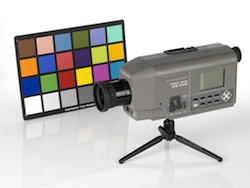
Oxygen DCT has launched a new service to help broadcasters and post facilities re-align and maintain LCD picture monitors with the correct broadcast colourimetry.
Picture monitors ‘drift’ from factory settings and need re-calibration because significant differences between the brightness and colour temperature of a group of monitors in a stack can be both irritating and tiring on the eyes. In the case of Grade One monitors, which are used for high-grade ‘reference’ assessment of picture quality, post production and transmission, poor alignment can lead to problems with quality control if broadcast engineers can’t tell if the monitor is at fault or the incoming signal.
Oxygen DCT’s new Colour Calibration Service aims to rectify the problem by re-aligning monitors and ensuring they comply with ITU Recommendation ITU-R709, which defines the sampling systems, matrix values and filter characteristics for both Y, B-Y, R-Y and RGB high definition component digital television signals.
Steve Hathaway, Managing Director of Oxygen DCT, said: “Colour Calibration Service is a new venture that we launched at the end of 2010 after receiving numerous requests from our broadcast and post production customers for help in re-aligning LCD displays.
“For some time now we have been offering this service on an ad hoc basis to customers using our LCD monitors, but by launching CCS we are now in a position to offer calibration facilities to the whole industry, from major broadcasters and post production houses through to small editing facilities and rental companies that want to ensure their stock of monitors remain fit for purpose. CCS can tackle calibration of every monitor on the market and we are not restricting this service just to the monitors that Oxygen DCT represents.”
Calibration can be carried out on-site or at Oxygen DCT’s Calibration Centre. As part of the company’s ‘Total Care’ policy it will provide temporary replacement monitors whilst a customer’s monitor is undergoing factory calibration. The service is headed by Dave Thompson, who has more than 30 years experience as a maintenance engineer and has recently been updating his skills on a training course in Germany.
All calibration is carried out using a Konica Minolta Chroma Meter CS-200, a new type of colourimeter that is specifically suited to measuring the viewable colour spectrum emitted from LCD panels.
This portable device incorporates a newly developed spectral filtering method that enables luminance and chromaticity measurement of single colours in various displays with accuracy comparable to many spectoradiometers. This is achieved by using the output from 40 sensors to calculate the spectral response corresponding to human eye sensitivity.
Hathaway said: “Using the CS-200 we can measure from a low luminance of 0.01cd/m² to a high luminance of 20,000,000 cd/m² (with a measuring angle of 0.1°). Measurements like these have been prevalent in the print industry for many years but this is the first time a service aimed specifically at broadcasters has been able to achieve such accurate results.”
CCS is already attracting business from major broadcasters including Channel 4, ITV and BBC Scotland. Customers using CCS can choose from a range of attractively packaged services that start with a basic health check of their monitors and go through to full ITU-R709 calibration. Prices start from £249 for ad hoc service and through to a contract basis, which is ideal for larger broadcasters who want to ensure their monitors stay consistently true and want regular checks.







